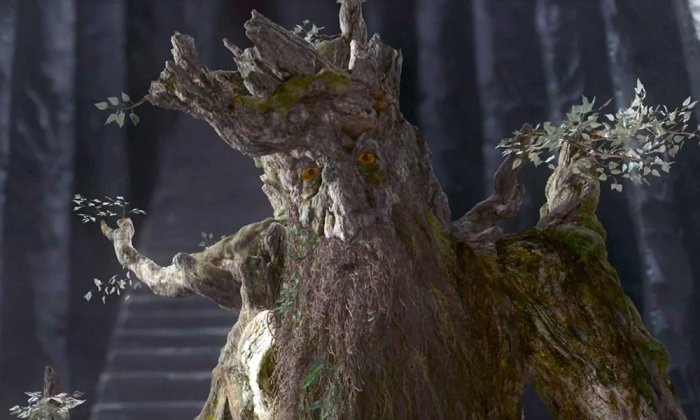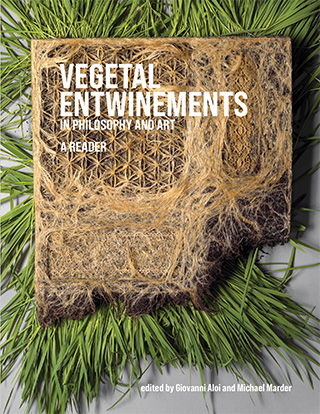The Ethics of ‘Talking Trees’

In recent years, philosophy and art have testified to how anthropocentrism has culturally impoverished our world, leading to the wide destruction of habitats and ecosystems. In their new book “Vegetal Entwinements in Philosophy and Art,” from which the following text is excerpted, Giovanni Aloi and Michael Marder show that the field of critical plant studies can make an important contribution, offering a slew of possibilities for scientific research, local traditions, Indigenous knowledge, history, geography, anthropology, philosophy, and aesthetics to intersect, inform one another, and lead interdisciplinary and transcultural dialogues.

Their book presents some of the most influential writing on plants, philosophy, and the arts, together with interviews and provocative new contributions, and considers such topics as the presence of plants in the history of philosophy, the shifting status of plants in various traditions, what it means to make art with growing lifeforms, and whether or not plants have moral standing. In the following excerpt, part of a longer chapter on the language of plants, philosopher Michael Marder explores the figure of “talking trees” that pervades various cultures, from the sacred grove of Dodona in ancient Greece, through vegetalized human beings in Dante’s “Inferno,” to the medieval Persian Trees of the Sun and the Moon.
-The Editors
The figure of “talking trees” traverses different cultures and seems to belong to the Jungian archetypes of the collective unconscious. In India, the rustling of leaves on a peepal tree is thought “to be done by supernatural beings, who speak by that means,” writes cultural geographer Frederick Simoons. Herodotus reports in “The Histories” that the cult of the oracle of Zeus at Dodona in northern Greece, also mentioned in Homer’s “Iliad” and by Socrates in Plato’s “Phaedrus,” was centered on an oak grove. The rustling of sacred oaks foretold the future, as interpreted by the oracle-priests of the Selli tribe: “The Selli listened to the rustling of the sacred oak and thought they could hear voices,” explains the archaeological writer Philip Vanderberg. “A question spoken with a loud voice in the wind found an answer in the sighing, whispering, and rustling of the oak trees.”
The list goes on: According to Buddhist traditions, trees that supplied the materials for the statues of Buddha could be observed weeping, speaking, or producing other miraculous signs. Alexander the Great came across prophesying talking trees in Persia; known as Iskandar there, he received predictions about his demise from the male cypress Mithra, the Tree of the Sun, and the female cypress Mao, the Tree of the Moon, which he later detailed in a letter to his mother. In the fables of Zhuangzi, in Dante’s “Inferno,” and in Tolkien’s “The Lord of the Rings” with its Ents, plants are endowed with anthropomorphic features, which invariably include the ability to speak.
The assumption that to have a language is to be able to speak is both erroneous and unethical.
In these and many other stories, the trees themselves speak — for themselves and, usually, with knowledge that is superior to that of human beings. But they do not all speak uniformly, in the same manner, through the same media, or in the same kinds of languages. The crucial difference between their ways of speaking has nothing to do with the (at times forced) divergence between literary and religious representations; rather, it concerns the narrow identification of speech with vocalization, as opposed to its comprehension in terms of giving signs.
The assumption that to have a language is to be able to speak is both erroneous and unethical. Its mistaken premise is thoroughly anthropocentric, insofar as it ties linguistic phenomena to the voice, which only humans possess, and grants other creatures the right to speak only on the condition that they ventriloquize quasi-, proto-, or posthuman voices.
When trees converse, as they do in Dante’s “Divine Comedy,” the silence of vegetal life, which does not preclude the plants’ self-expression, is broken and disrespected. The sentient trees inhabiting his “Inferno” weep, moan, and emit “loud, unhappy voices.” From a broken twig, “words and blood” (parole e sangue) gush forth together. And the bush Dante addresses says in response: “Indeed your sweet words break me / Away from silence [non posso tacere]: let it not weigh on your ears / If I am enticed to prattle a bit, for your sake.” We learn that these infernal talking plants are the souls of those who, having died by suicide, are punished with vegetal incarnations for taking their lives. If these plants are allowed to speak, it is because their bodies are but the vehicles for human spirits, pieces of sentient matter that trap the souls of sinners and cause them pain and suffering: “in the poisoned shade of the bushes we are.” Simply put, hell, for Dante, is human thought, speech, and sensation trapped in the body of a plant.
Instead of translating the language of trees into its anthropic equivalent, we witness a substitution of plant communication with the human-centric aspects of our behavior. Moreover, this act of substitution does not recognize the origin it has erased: It does not register the existence of plant languages it has automatically denied and replaced with speech.
Not every author imagining speaking trees succumbs to such blindness, however. The cult of Dodona inspired James Howell’s 1640 political allegory “Dendrologia: Dodona’s Grove, or The Vocall Forrest,” which narrates the history of England and Continental Europe with the help of talking trees. Howell’s poetic opening sentence is worth citing:
It fortun’d not long since that Trees did speake, and locally move, and meet one another: Their ayrie whistlings and soft hollow whispers became articulate sounds, mutually intelligible, as if to the soule of vegetation the sensitive faculties and powers of the intellect also had beene co-infused into them.
The similarity between trees and people was, in Howell’s world, a two-way street. While the former spoke like the latter, early human discourse bore a semblance to the rustling of leaves:
in the nonage of the world, mens voyces were indistinct and confus’d; and sojourning chiefly in the Woods, by a kind of assimulation and frequent impressions in the eare, they resembled those soft susurrations of the Trees wherewith they conversed.
The hypothetical convergence of vegetal and human discourses evinces, at the same time, respect for the potentialities of plant language and modesty with regard to the capacities of the early representatives of Homo sapiens. Howell does not endeavor to erase the vegetal origin in an act of thoughtless substitution but, on the contrary, attempts to construct a richer and more fluid version of plant existence that reverberates with other forms of life. Still, the markers of intelligence in his account are drawn from a set of largely unquestioned human values, ranging from locomotion to abstract thought and, of course, vocalization. Given the anthropocentric parameters of Howell’s world, then, it makes no sense to delve into the difficulties of translating plant languages into their human counterparts, and vice versa, not to mention to care about what remains untranslatable in this carryover.
Although Master Zhuangzi’s tale about Carpenter Shi and an oak, dating back to the late Warring States period in China (third century bce), also puts words in the “mouth” of a tree, it is acutely aware that plants, as well as all other living beings, live in excess of the value systems we thrust upon them. The carpenter’s complaint about an old oak he encounters near a village shrine is that it is useless — neither yielding edible fruit nor timber that could stay afloat if used to build a boat. When the oak appears in his dream, it queries him about the value of value, understood in the sense of usefulness. The utility of fructiferous trees, it states,
makes life miserable for them, and so they don’t get to finish out the years Heaven gave them but are cut off in mid-journey. … As for me, I’ve been trying for a long time to be of no use. If I had been of some use, would I ever have grown this large? Moreover, you and I are both of us things. What’s the point of this — things condemning things? You, a worthless man about to die — how do you know I am a worthless tree?”
The lesson of the tree is that all existence is worthless from the standpoint of instrumental rationality and that its real worth lies in this absence of utility. More than that, human beings cannot presume to know that their scales of value extend to all creatures, including plants. The thingly nature of the carpenter and the oak implies their finitude, which simultaneously unites and separates them. Now, all this is said in a speech that, delivered by a tree, subtly undermines the prominence of spoken discourse, which, too, is a disproportionately inflated human value. After all, the determinations of the worth or worthlessness of plant languages must contend with the analogous dilemma of the divergent axiologies, or valuations, corresponding to different modes of life.
We must strain to listen to the inaudible, if we are to be in touch with the future and with the language of plants themselves.
Perhaps the most ethically attuned among the narratives of talking trees are those that do not conflate speech with vocalization. When ancient Hindus listened to the rustling of peepal tree leaves, trying to discern the conversations of celestial nymphs (apsarās) said to inhabit them, and when ancient Greeks engaged in fortune-telling based on the same sound produced by the wind as it passed through an oak grove, they imbued the interaction of plants and the elements with a secret meaning. To distill meaningful signs from the sounds that leaves, branches, and currents of air emit in concert is not to force a human semantic form onto the language of plants, but to attend to them in the places of their growth. It is also to acknowledge the untranslatable and the indiscernible, what cannot be picked up by the human ear and what exceeds our every interpretative venture, oriented toward the communication (if not the communion) of plants and the elements. Not by chance, the absence of speech from this language parallels the desire to glimpse a temporal absence, namely, the future.
Since the future is not a fixed, substantive object of knowledge, a suitable approach to it cannot rely on the rigid mechanisms of comprehension and identification, built into human cognition and speech. We must strain to listen to the inaudible, if we are to be in touch with the future and with the language of plants themselves.
Michael Marder is a philosopher who teaches at the University of the Basque Country. His other books include “Plant-Thinking: A Philosophy of Vegetal Life,” “The Philosopher’s Plant: An Intellectual Herbarium,” “Philosophy for Passengers,” and “The Phoenix Complex.” This article is excerpted from the book “Vegetal Entwinements in Philosophy and Art.”



